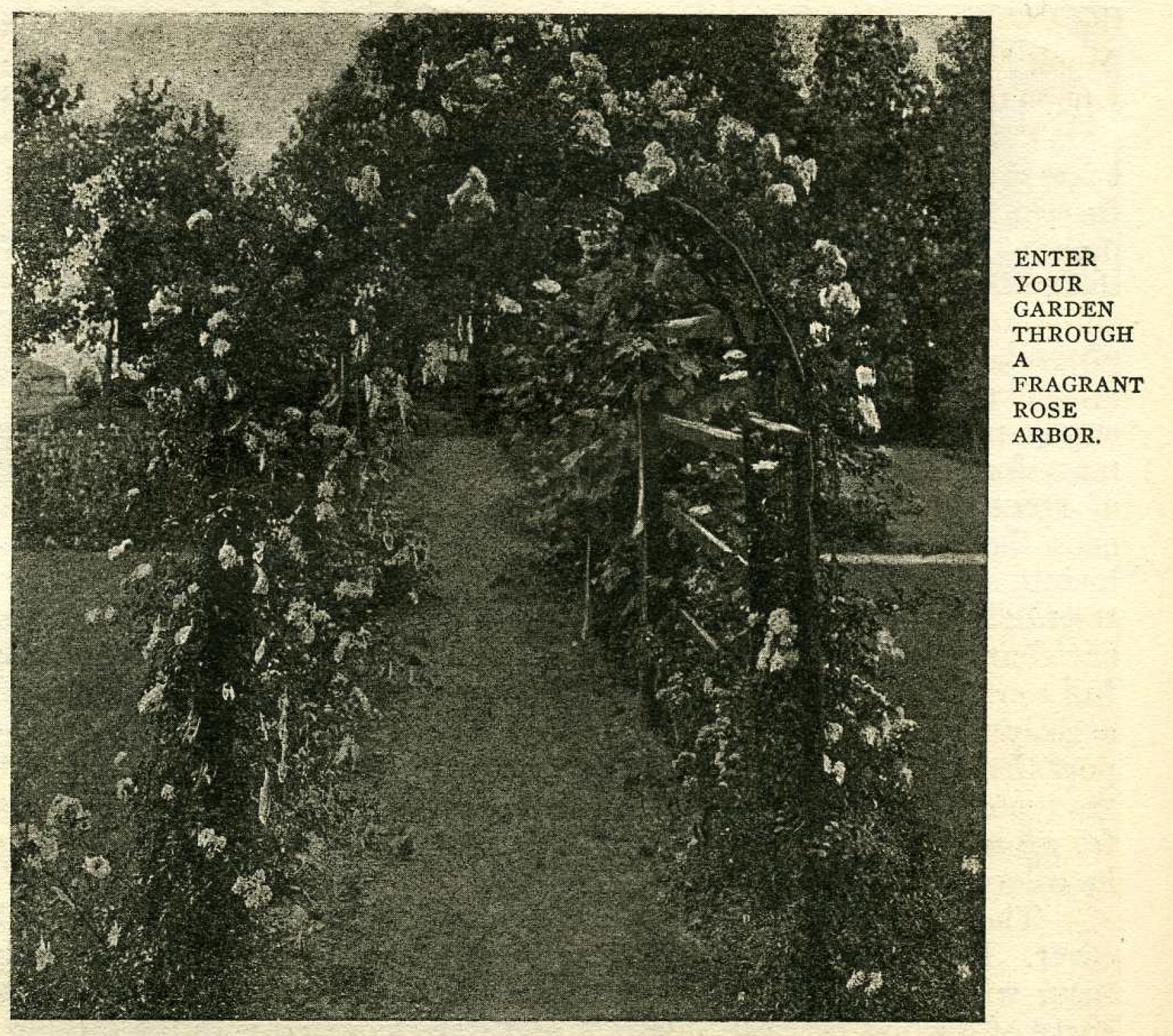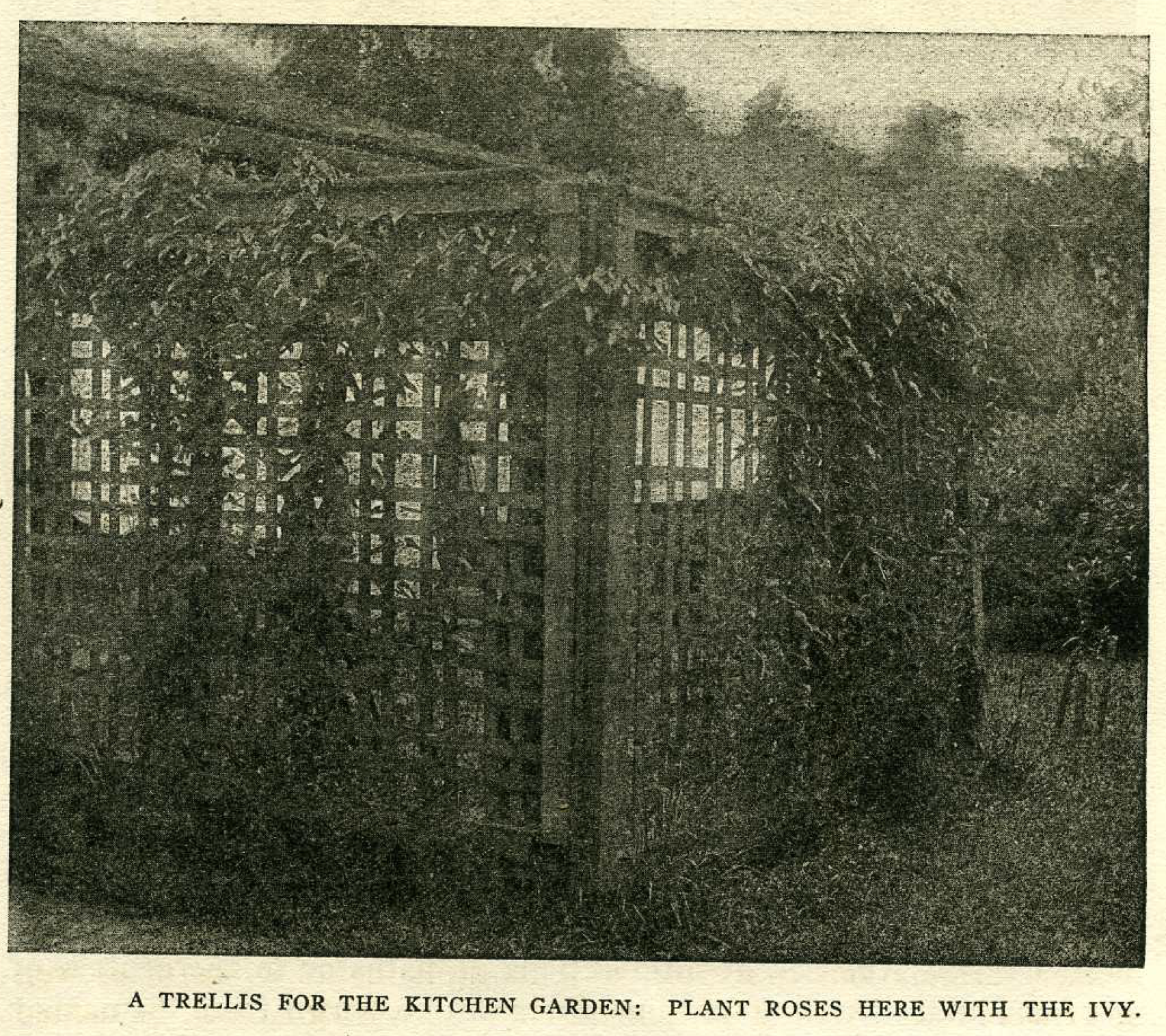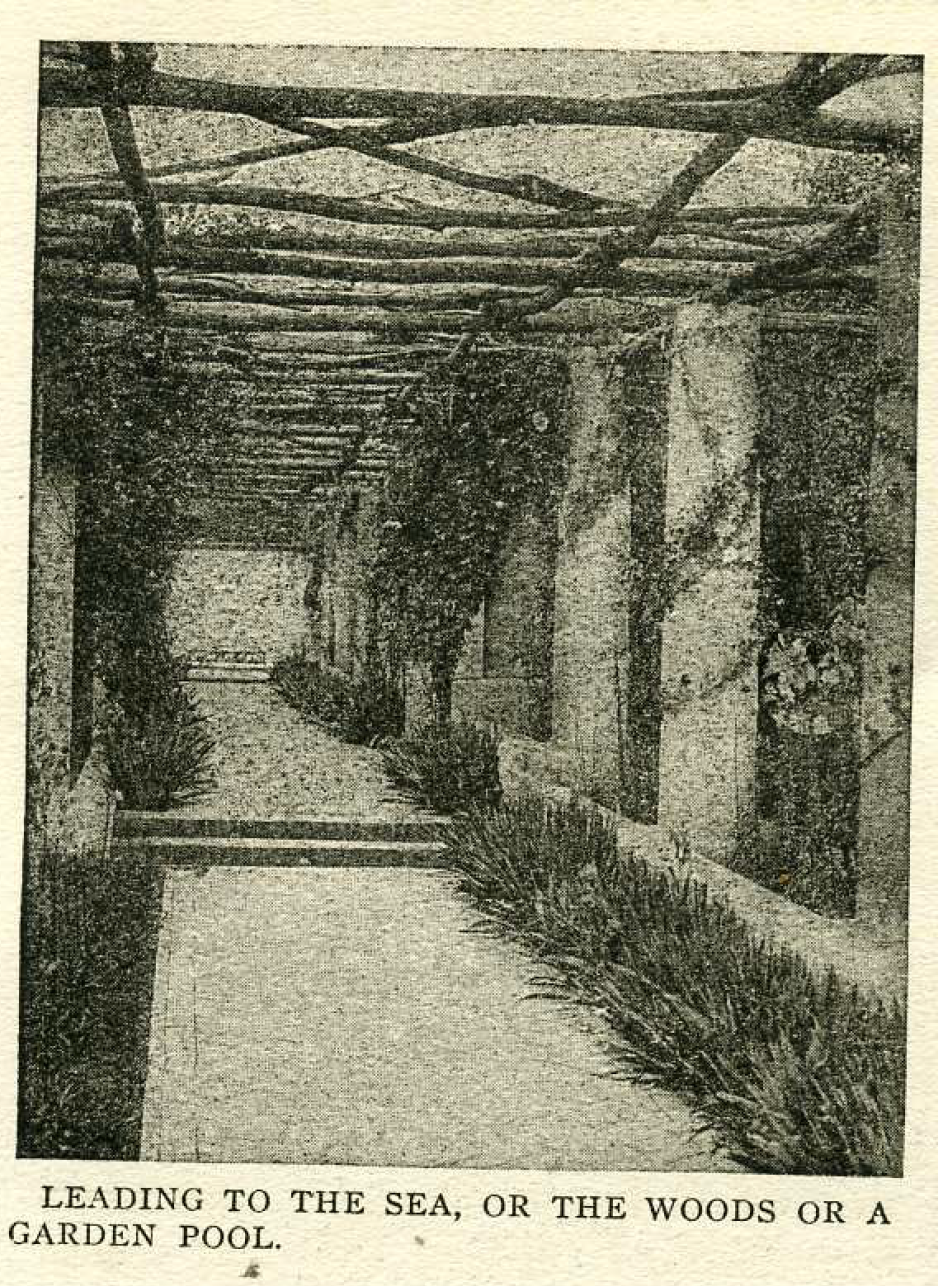Pergolas, arches and roses.
"Pergolas, arches and roses." Touchstone 6, no. 6
(March 1920): 403-406.
[https://library-projects.providence.edu/rosarium/view?docId=tei/rg0016.xml]

Gracious as the queen of fairyland whose presence lifts all situations into immediate beauty, is the rose. The rose is always likened to a queen. Not the queen who walks disdainfully among slaves and retainers, but the one who, by the touch of a hand or the kindly word, lifts worshippers to knighthood. There is never the false note of superiority about a rose. She is as beautiful blooming by dusty road sides as she is in a palace garden. Wherever she blooms, the ground, even the air, about her becomes a magic place.
There is nothing more suitable for a little garden than a rose and surely nothing is more fitted to adorn a royal park than this same marvelous flower. Whether she encircles a tiny garden with a hedge of green covered with pink or white blossoms, or whether she climbs over the lowliest cottage to crown it with beauty she does it with loving, friendly grace, not in the arrogant way that makes favors resented. There is scarce a situation in any garden where the rose is not charming, but perhaps the most ideal device for bringing out the full perfection of this gifted flower is an arch. An arch gives a rose exactly what it most needs to bring its blossom to perfection—a support that permits it to wind in and out without binding, that gives it the nourishment of free winds and that enables it to hold its blossoms far up where the air is fresh and there is no danger of storms defiling its colors by beating them into the dust.
There is a kind of rose in California that is used as a ground cover. Its long branches are trained over unsightly ledges by pinning them with wire hoops close to the ground. Sometimes one sees a space of ground between sidewalk and street covered with the shining, clean looking leaves of the rose vine from which arise a mass of pink or white blossoms. No more wonderful ground cover could be imagined. But lovely as it is used in this way, it cannot touch the regal beauty attained when given an arch to climb upon. Even a climber likes to trail the tips of its branches downward and swing them in the wind. Here again the arch gives the rose its perfect opportunity, for it can climb up one side, hold the mass of its blossoms in the sun at the top and drip them down on the other side. A climbing rose must be given its own way. It must not be too tightly trained and clipped.
It would be impossible to print a full list of climbing roses that like an arch or those that roof a pergola most delightfully. Everyone knows the charming "Cecile Brunner" and the brilliant "American Pillar." In the list given by George C. Thomas in his "Practical Book of Outdoor Rose Growing" he praises the "Hiawatha," "Silver Moon," "Cloth of Gold," "Gloire de Dijon," "Maréchal Niel" and a number of "Hybrid Wichuraianas," some white and some pink, some even shaded to old gold as well as yellows and gold which seem like captured sunshine. He says that climbers need more water than low-growing roses because of the greater evaporation due to greater exposure to sun and air.
The rose is by many considered the most perfect curtain for those charming outdoor rooms created by pergolas. Next to this garden favorite for use on pergolas is perhaps the Wistaria which drops its pendant lavender and white blossoms between the network of beams when spring is at its height, and during the summer its dense mass of leaves create just the shade most desirable. Another wonderful vine for a pergola is the grape, which from spring to latest fall exhales fragrance of blossom and fruit. Its leaves are decorative and branch terminations graceful, while its fruit makes it useful as well as ornamental. Among other good vines for a pergola may be named the Clematis, Honeysuckle, Hop, Kudzu, Japanese Morning Glory, Moon Vine, Alleghany Vine and Bitter Sweet. Another wonderful vine is the climbing Hydrangea.
Pergolas are awkward things when first made before the vines have given them the finish which they require. The best vines for forming walls and roof of pergolas are slow growing, and garden makers are impatient folk and do not like to wait several years for their ideal to become manifest. Therefore they call in the cheerful willing service of the annuals which in one season will twine the empty pillars with green and decorate them with fairy trumpets of Morning Glory, the scarlet butterfly wings of the Red Runner Bean or the white stars of the Wild Cucumber. For those who wish quick cover the common Gourd is to be recommended. Its great leaves are wonderfully effective, its yellow blossoms bright and cheerful and its fruits humorously decorative.
Roses can be used in a great many interesting ways beside the charming ones of creating outdoor rooms of pergolas and of centering garden pictures by climbing in and out of an arch. When planted over the porch of even the humblest cottage they lift it to a thing of beauty. They redeem any old stump, and give romantic beauty twined around a sundial. When planted at the base of a standard birdhouse they give sure protection to the nestlings, because no enemy cat will attempt to climb up to a nest so sharply guarded.
Roses make the most delightful of division fences, as well as hedges. When grown as a hedge they are kept clipped to a desired height, but when used as fences they are planted at the base of a post and allowed to run along strong wires connecting the posts, thus forming festoons of color and fragrance. We have seen such fenceways in California made of posts perhaps six feet tall and the wires between not strung tautly but allowed to curve so that the roses, when following the wire, create a decided wave effect around the entire place. Sometimes the design is varied by planting tall arches of iron between each fence post so that the fence is a succession of arches which frame pictures from every angle.
Still another charming way to use roses in a garden is to plant them beside an ornamental well curb, letting them climb up over the iron work that ordinarily would be supporting the wheel used to draw up the water. Italians well understand the ornamental value of well-designed well curbs. Of course it is very expensive to bring these treasures from Italy, but fortunately we can get very good copies in this country which have a distinct esthetic value. These copies have been used in America at intersections of paths or in the centers of gardens, and, though no cooling water can be drawn from them, they support a rose vine most gracefully.



